









Solutions for sport, leisure and exercise environments.

coverings available in both sheet or tile format.
Seamless polyurethane


Maple hardwood performance surfaces.
Recycled rubber crumb shock pads and acoustic underlays.



noise and vibration transmission.
Acoustic wall panelling.









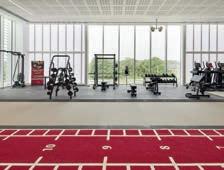


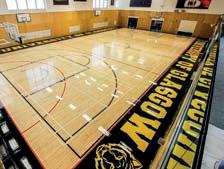




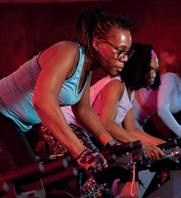
“We could actually put a handle on what we were doing, and the culture within the business led us to start developing more and more in terms of what we are doing” (p26)

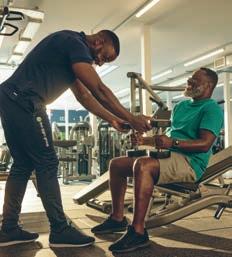

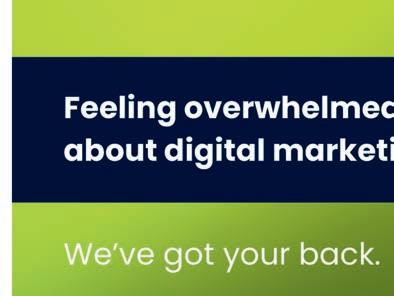



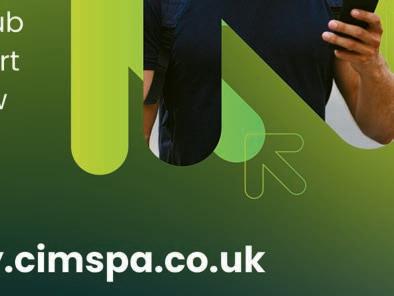

D] DeeDee Doke

oesn’t it seem as though the past winter has been one of the longest ever?
Participants in outdoor sport and physical activity will likely be feeling the same, as poor weather bombards events large and small, forcing cancellations, postponements and damaging precious facilities.
For the moment anyway, the weather conditions can’t be changed. But from defining new approaches to building material use for facilities to combatting climate change, our S&PA sector is setting standards for creating a sustainable future.
See our news and feature on p6 and pp24-29 to glean insight from Sport England and The Gym Group about their strategies.
Of course, artificial intelligence (AI) creates another omnivorous, shapeshifting presence across, especially, our work world. However, our assistant editor Patrick Appleton tells us that AI can be our friend in the sector as well as an ogre. Get the latest on making AI a workplace bestie on p32.
Swimming is not only a sport skill, it is a life skill. Swim England’s new CEO, Andy Salmon, reminds the S&PA sector in his call to action on
p8. Just four months into the role, he is calling for collaboration among sector bodies to boost the lagging numbers of swim instructors needed to teach youngsters to swim. Make this summer memorable!

Contact us on X, formerly known as Twitter at @SAPA_Pro and email at sandpa@redactive.co.uk
EDITORIAL
Editor DeeDee Doke
Assistant editor Patrick
Appleton
Designer Will Williams
Production editor
Vanessa Townsend
Contributors Dean Gurden, Sue Weekes
Picture editor Akin Falope
Publishing director
Aaron Nicholls
ADVERTISING
Sales
020 7880 6230
sandpaprof@redactive.co.uk
PRODUCTION
Production director
Jane Easterman
Senior production executive
Rachel Young
SUBSCRIPTIONS
S&PA Professional is available to selected members of the Chartered Institute for the Management of Sport and Physical Activity (and is available on subscription to nonmembers). All member enquiries should be directed to CIMSPA.
For enquiries from non-CIMSPA members, call 01580 883844 or
email subs@redactive.co.uk
© Redactive Publishing Ltd.
S&PA Professional is published on behalf of the Chartered Institute for the Management of Sport and Physical Activity (CIMSPA) by Redactive Publishing Ltd. All rights reserved.
This publication (and any part thereof) may not be reproduced, transmitted or stored in any print or electronic format (including but not limited to any online service, any database or any part of the internet) or in any other format in any media whatsoever,
without the prior written permission of the publisher.
Redactive Publishing Ltd accepts no liability for the accuracy of the contents or any opinions expressed herein.
Printed by Manson Group ISSN 2050-7747
CIMSPA ENQUIRIES
Chartered Institute for the Management of Sport and Physical Activity
SportPark, Loughborough University, 3 Oakwood Drive, Loughborough, LE11 3QF
Tel 03438 360 200
E-mail info@cimspa.co.uk Web www.cimspa.co.uk
Recycle your magazine’s plastic wrap – check your local LDPE facilities to find out how.
A round-up of the latest developments in the industry

Sport England has launched its first-ever environmental sustainability strategy, which includes investing heavily in helping the sport & physical activity sector respond to climate change.
The package is worth more than £45m of new National Lottery funding and builds on previously announced £80m joint investment by Sport England and the government in the Swimming Pools Support Fund to make hundreds of swimming pools across the
country more environmentally and financially sustainable.
This latest funding will be used “to help more people get active in nature, restore flooded sports pitches and help sports clubs become sustainable”, Sport England said.
Sport England cited new research revealing that three in five adults and children say extreme weather has had a negative impact on their ability to be active, with one in four of the children negatively affected by, for
instance, the cancellation of PE and games lessons.
“There is no doubt that our climate is already impacting our opportunities, motivation and ability to be active,” said Chris Boardman, Sport England chair.
“Extreme weather is making it difficult for us to live healthy, active lives by creating a ‘doom loop’ where people become less motivated and more fearful of injury, with sporting opportunities increasingly cancelled and disrupted.
“Without change now, the government’s target to get 3.5m more people active by 2030 is very much in jeopardy – and our children will be the ones to suffer most.”
The new Sport England strategy will: require 130 system partners, including the NGBs of all major recognised sports in England, to have robust sustainability action plans in place by March 2027 as a condition of their funding mean working with partners and stakeholders to ensure end-of-life recycling for all newly funded replacement artificial grass pitches from June 2024, as a condition of funding become a signatory of the UN Sports for Climate Action Framework and act as a global advocate for positive change reduce its own carbon emissions by 50% by 2030 and make net zero by 2040.
“It’s not too late to make a difference. Today’s [16 May 2024] strategy launch is a vital moment for the sports and activity sector and together we can unite to fight against the impact of climate change,” said Boardman.
S&PA Professional has requested comment from Sport Northern Ireland, Sport Scotland and Sport Wales on their sustainability plans but received no response at time of press.
See pp24-29 for insight on how The Gym Group has developed a path to sustainability, and more on Sport England’s strategy.
By DeeDee Doke
Sports clubs in Wales are now able to apply for an Energy Saving Grant up to the value of £25,000.
Boxing champ Joe Calzaghe (pictured) knows all about the grants’ punch: the family-run Calzaghe Academy in Newbridge is among the 79 sports clubs who successfully applied to Sport Wales for the full amount last year to make its facilities more energy effi cient. By installing solar panels and upgrading its insulation, the boxing foundation will save thousands of pounds off its energy bills for years to come, providing more financial stability to continue the boxer’s legacy in his hometown.
“We’ve trained many champions, and boxing was everything to me as a kid. I had a tough time at school, was bullied and was quite introverted,” said Calzaghe. Coming to a gym gave me my self-worth, and that’s what we’re all about –providing somewhere for kids to have fun, get fit and feel good about themselves.
gym and give the kids a better environment to train in.”
As well as solar panels and insulation upgrades, other energy saving measures that clubs might consider applying for include installing energy efficient LED lighting and motion sensors, improving heating and hot water systems, as well as sustainable water sourcing.
Age and usage of a sports facility will determine the potential savings too. The older a building is, the more chance of cost-benefit energy efficiencies being made.
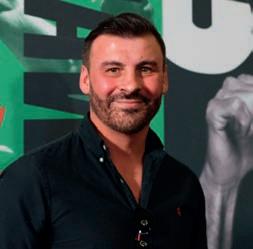
Likewise, a clubhouse or pavilion that is open and consuming gas and electric every day of the week is naturally going to have more potential for energy ciencies than a facility which is only in use a couple of times a week.

I’m writing this just after the General Election announcement for 4 July. Between now and then, we’ll see campaigners setting out their plans to address some of the biggest issues that the country is facing.
At CIMSPA we’ll be championing how our sector is integral to addressing two of the key issues: reducing demand on the NHS and supporting sustainable economic growth.
Alongside that we’re continuing the drive to embed professional recognition across the sector. On p16-17, we delve into why professional recognition matters and what it truly means for sport and physical activity (S&PA) professionals and the sector. We explore our new categories of professional statuses, from practitioner to advanced chartered practitioner. These clear, standardised categories will transform the way skills and competencies are acknowledged and understood. They will also help employers identify the right talent for specific roles.
“The grant from Sport Wales will really help us reduce the cost of running the
“Clubs who are successful with their applications will not only benefit from cheaper utility bills so that they can become more financially sustainable but, just as importantly, they’ll also be doing their bit for the environment by reducing Welsh sport’s carbon footprint,” said
Brian
Davies, CEO
of Sport Wales.
Our focus on professional recognition is about unlocking the true potential of the S&PA profession. By bridging the gap between sports and health, S&PA professionals can develop meaningful partnerships with allied professionals to support diverse populations.
Gaining greater recognition will enhance our reputation, increase confidence in our profession and acknowledge the contribution our sector makes to health and wellbeing, the economy and beyond.
Whoever forms the new government should take note – our profession is the catalyst for so much.
By Patrick Appleton
The new CEO of Swim England has called on the organisation to ensure it drives plans to make certain that every child in the country is able to swim.
He also expressed a desire to work collaboratively with any new government and CIMSPA to tackle the issues the sport and physical activity industry face.
Andy Salmon has only been in the role for three months, but has been proactive in his approach, helped by a series of Swim England roadshows up and down the country to allow others to hear his and the organisation’s plans for change across the board.
“Cultural change is very important –but also, here’s the sport that is the most widely participated sport in the country,” Salmon told S&PA Professional in an exclusive interview in London.
“Swimming goes way beyond physical activity – it’s an absolute life skill, it can save somebody’s life if they fall into water, and they need to be able to swim to prevent themselves from drowning. However, it’s also a life skill in terms of the confidence it can give you, and the positive impact on your health too.”
According to Swim England, the activity generates £2.4bn of social value in England every year and “prevents more than 78,500 cases” of ill health annually, including more than “22,000 cases of diabetes and 2,500 cases of dementia, saving the NHS over £209m” as well.
“Swim England has the insight; we’ve got the resources, the personnel to help those operators in running the pools creatively,” Salmon said. “Also, of course what’s very important to all of us is that we want every child to be able to swim. We can work together with the members of CIMSPA to make that a reality.”
Salmon has taken over from previous incumbent Jane Nickerson, who retired
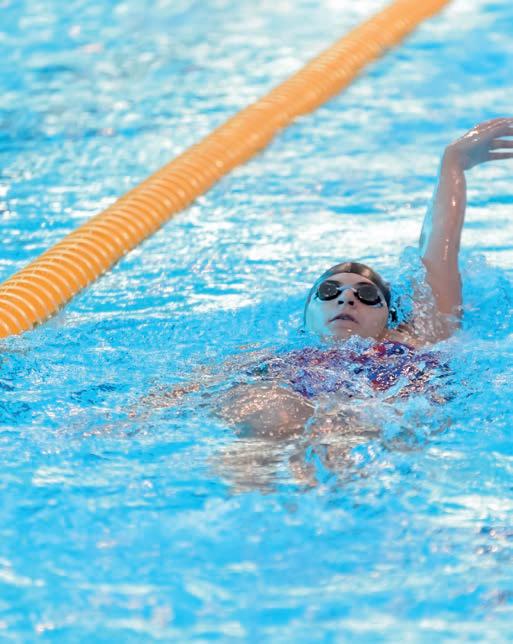
after 25 years with the national governing body (NGB). He wants to continue to reach out to CIMSPA and carry on the good work that happens throughout the industry.
“Swimming goes way beyond physical activity … it’s also a life skill in terms of the confidence it can give you, and the positive impact on your health too”
“I think the fundamental message to CIMSPA members is that, yes, we are a governing body, but what is really relevant to CIMSPA and its members, is that we’re here to help,” said Salmon.
“Pools are more expensive to run than they were five years ago, as energy costs have gone up. However, there are so many ways that pool operators can, and are being creative and businesslike and how they manage those pools.
“Aquatics can be a real driver of revenue. So perhaps in some cases, that requires a mindset shift – let’s not think of the pool as being this really expensive asset we’ve got in our leisure centre or facility.
“It’s an asset that we can really monetize as well, that we can bring

about not just financial good, but social good, by targeting different groups, by helping people enjoy the experience of swimming, and realising all the health benefits that come with that.”
Regarding the different issues the sector faces, particularly swimming and pools across England, Salmon noted that almost 1,200 pools in the current pool stock are more than 40 years of age and further to the point, sustainability needs to be embedded into any future swimming pools, be that brand new or renovated.
“We need financial sustainability to be

at the core of those designs, but also environmental sustainability – what is the energy consumption requirements,” he said.
“As an organisation, we need any future governments to be really investing in those indoor facilities. Green technologies can drive that, and again, our team has been involved in some research and advice to operators around [the sector]. For example, how can you take the energy and heat created by [digital] servers and convert that energy into heating too? There is some fantastic evidence around this. There are all sorts of exciting and innovative ways that we can make that pool stock more sustainable in every sense of the word.”
According to Swim England, leisure centres could be “as much as 40% of a local authority’s direct carbon emissions”. It added that if any local authorities want to meet net zero they must address the ‘leisure centre with swimming pool’ issue.
According to Swim England 2023 statistics on the workforce:
21% of people going through the Recruitment Academy to become swimming teachers are from ethnically diverse backgrounds, a number which has risen from 8% in just two years
The swimming NGB issued more than 25,000 qualification and training certificates to its teaching and coaching workforce through Swim England Educator training and qualifications




‘SEIZE THE OPPORTUNITY’ FOR SPORT AND PHYSICAL ACTIVITY
By DeeDee Doke


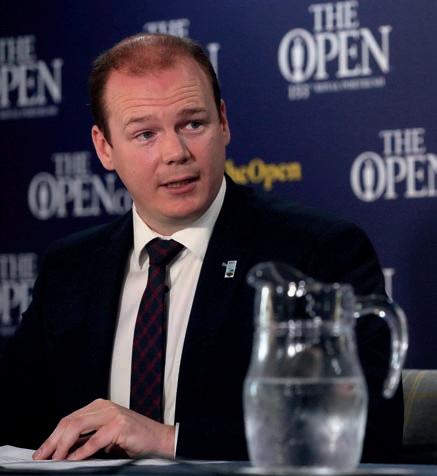
Northern Ireland communities minister Gordon Lyons has announced a long-term programme of £36.2m investment in local footballing facilities at all levels of the game.
“I am seizing this once in a lifetime opportunity to transform the game locally,” Lyons explained. “For players at performance and grassroots level I want to see better facilities and improved accessibility, both as participants and supporters.”
The Member of the Northern Ireland
Assembly (MLA) for East Antrim added that he was “committed to fully utilising” the funding and seeking to get further investment from the NI Executive too.
Lyons said that the funding would take a phased approach to delivery across its three strands, with the club investment strand opening for applications within the financial year (FY). Clubs will be able to start spending their grant in FY2025-26.
In further good news for NI local sport and physical activity, Sport NI is within reach of achieving its target of half a
million grassroots sport club members by 2027-28, it told the Northern Ireland Assembly’s Committee for Communities.
In 2023-24, the governing body’s £8m National Lottery-funded Sports System investment programme drove sporting club membership to 433,000, a 47% increase from the 295,000 base figure in 2017-18, said Sport NI’s interim CEO, Richard Archibald.
Last year, Sport NI invested in six new governing bodies of sport: American Football, British Powerlifting, Kickboxing Ireland, Irish Olympic Handball Association, Irish Squash and Irish Surfing.
Sport NI also invested in ParkRun for the first time, along with providing financial support to larger and more established sports organisations.
Other highlights of Sport NI’s report to government:
Membership of women and girls has increased from 114,000 in 2017-18 to 159,000 in 2023-24.
Sport NI is also committed to supporting the nation’s athletes to perform on the world stage, representing NI, Ireland or Team GB, creating so-called Medal Moments and in turn inspiring others to engage in sport and physical activity.
High performers across a wide range of sports achieved a record haul of medals for Team NI at the Birmingham Commonwealth Games 2022 with more women, girls and para-athletes participating than ever before.
To improve financial management at Sport NI, a board sub-group has been set up to work with an interim management team. It identified a number of “areas of concern”, Archibald said, and is taking agreed steps to address these. He also said the interim management team had “successfully re-established financial controls” in Sport NI and had been delivering timely and accurate financial information to the board.
By DeeDee Doke
The biggest reasons that non-members of gyms or leisure facilities give for not holding memberships are the cost, feeling uncomfortable at a leisure facility or lacking confidence to join, say key learnings of ukactive’s recently released ‘Consumer Engagement’ survey.
Split into three respondent categories – ‘member’, ‘former’ and ‘never been a member’ – the survey also covered the motivations encouraging people to be a member, with a UK nationally representative (age, region, gender, social) minimum sample of 2,000 adults.

Respondents that held a current gym membership gave all the reasons that motivated them, some of the top reasons being ‘to improve or maintain either physical strength and fitness or their mental health and wellbeing’, ‘along with improving confidence’, ‘physical appearance’ and ‘sleep quality’. Lowest motivation factors were to ‘make new friends’ (46%) or ‘getting fit for an important event such as a wedding or holiday’ (43%).
The Consumer Engagement survey work is part of ukactive’s ‘sector intelligence’, which is intended to help drive the organisation’s Vision 2030 and its goal of 5m more people using gyms, pools and leisure centres.
“We know memberships or participation in facilities is increasing, but what motivates people to attend and take part in activities, and what barriers still exist?” the report said.
The survey found that walking is the standout favourite activity for both former gym/leisure facility members and those who have never been members.
When asked about physical activity levels, 21% of ‘active’ participant respondents, reported that they achieved the standard target of 150 minutes per week between September 2022 and January 2024, with about 40% of respondents defining themselves as ‘fairly active’, garnering 31 to 149 minutes per week.
British Cycling has published its first sustainability strategy, with the view that the organisation will achieve net zero by 2035.
The long-term strategy also hopes to deliver a 50% fall in carbon emissions by the end of this decade, with sustainability consultants Think Beyond jumping on board as well as contributions from across the cycling community.
It also sets out the British Cycling “vision to become world leaders in the delivery of sustainable events”, and will “continue to advocate for more people to make short journeys” by bike.
A detailed baselining exercise found that the cycling organisation’s total carbon emissions equated to 10,824 tonnes of
CO2 e – equivalent to the annual emissions of more than 850 UK citizens.
Of those emissions, the cycling national governing body (NGB) found that the largest contributions came from its supply chain (55%), business travel (34%) and electricity for HQ at the National Cycling Centre (4%).
The organisation has already made progress on several measures to reduce those carbon emissions. One such example is the NGB’s ambition to transition its fleet of cars and vans to low and zero-carbon vehicles, with
the support of its partner Shell UK. Through the Shell Avelia platform, it will off set 353.08 tonnes of CO 2 e, lessening all of the Great Britian Cycling Team’s projected air travel in 2024.

British Cycling has also created a new Planet Positive programme to provide funding and resources to grassroots event organisers.
Additionally, the body has applied to become a signatory to the UN Sports for Climate Action Framework, having already been a founding signatory of the UCI Climate Action Charter.
If you’ve walked into a new leisure centre, which doesn’t look much like a traditional leisure centre, the chances are that Alliance Leisure has had a hand in it. Serving the industry for 25 years, the leisure development specialist are behind some of the most exciting, forward-looking physical activity spaces in the public sector today. From climbing walls and interactive assault courses to tenpin bowling and even spas, the company is reshaping the public leisure landscape.
Back in 1999, in addition to providing financing, Alliance Leisure started refurbishing and repurposing facilities, mainly modernising gyms and converting under-utilised squash courts into more usable, revenue-generating spaces such as soft play. Since then, the company has evolved to become the UK’s leading expert in public sector leisure development.
The journey has been peppered with industry firsts, including building the
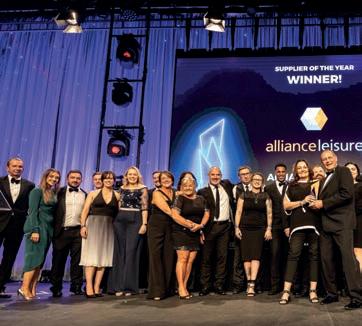

first public sector spa for Pendle Leisure Trust and Europe’s first Flight Tower with multiple descents, including a zip line and free fall, as part of a £5m redevelopment of Salt Ayre Leisure Centre for Lancaster City Council. Alliance Leisure also delivered a £17m destination waterpark in Rhyl for Denbighshire Leisure. Known as SC2, the project played a critical role in Rhyl’s wider waterfront regeneration. The first of its kind for local leisure
provision, it included a large indoor waterpark with thrill seeking rides, an outdoor splash pad, food and beverage outlets, as well as the first TAGActive indoor assault course in North Wales and the UK’s first JuniorTAG.
Paul Cluett, Managing Director at Alliance Leisure, comments: “Being appointed as the leisure development partner to the UK Leisure Framework

(UKLF), which is owned and managed by Denbighshire Leisure (DLL), has been a game-changer for us. We’ve seen the value of our projects increase from £1-2m to more than £40m. As the UK’s first construction framework dedicated solely to leisure, the UKLF offers a comprehensive solution for leisure developments, with a potential investment value of £2 billion.”
Open to all UK public sector organisations, the UKLF helps mitigate investment risk by utilising expertise in leisure regeneration and maximising
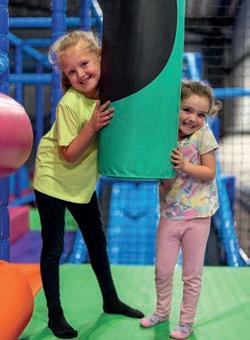
Year founded: 1999
Projects completed: 250+
Investment value: £370m
Projects in development: £300m
Turnover: £100m+
Employees: 38
efficiencies throughout the development process. Streamlining the traditional design and build process, the framework avoids the competitive tender process. This can reduce procurement time by as much as six months allowing local authorities to make efficiencies in the early stages and reduce inflation costs.
All suppliers appointed to the UKLF have extensive experience in the leisure industry, so decisions, designs and execution are all informed by years of best practice. The framework also takes a holistic approach, supporting all aspects crucial to successful and sustainable leisure development, including design, business planning, funding, construction and marketing.
Over the past five years, Alliance Leisure has delivered 96 projects through the UKLF, with an additional £300m currently in construction. Many local authority teams are thinly stretched, and adding a multi-million pound leisure development project to their workload is often beyond their capacity. Under the UKLF, Alliance Leisure leads project delivery from concept to completion and even in the months beyond, through its TA6 marketing division to ensure facilities are successful and sustainable in the long term.
Alliance Leisure offers a lifeline to much-needed community facilities. When old centres no longer meet community needs and become a drain on resources, very often the immediate reaction is to close them. However, the success of Alliance Leisure’s projects demonstrate that redevelopment and reinvestment in leisure provision can yield economic, health and social cohesion benefits for communities, offering an invaluable return on investment. With extensive research and consultation – both with users and non-users – they create centres with a facility mix tailored to community need, that appeal to a broader population base and are economically viable.
Sarah Watts, CEO at Alliance Leisure, is proud of the company’s track record. “I always say my greatest achievement is my three daughters, but Alliance Leisure is my fourth child. Since launching the business 25 years ago, we have delivered more than 250 projects with an investment value of £370m. With a current turnover of £100m, we are on track to reach £150m.
“This level of success only comes with a strong team. Both Paul and I actively nurture talent and strive to create a culture which empowers people to thrive. We are a tight knit community and I’m proud that we have been able to maintain a sense of family as the business has grown. Our focus now is on steering Alliance through this next stage of growth, while upskilling key members of the team to ensure its continued success in the future.”
For more information about Alliance Leisure visit www.allianceleisure.co. uk or email info@allianceleisure.co.uk

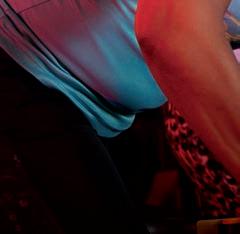


Everyone knows the benefits of being active, but sometimes the battle between exercising and tackling emails is all too real

As the Managing Director of Sport England’s quality assurance scheme, Quest, and specialist leisure sector support company, Right Directions, Caroline Constantine knows a little about the benefits of physical activity.
“I’m most operators’ typical target market,” she says. “An overweight, tired, quite stressed woman in her mid 50s, juggling to achieve a decent work-life balance. I’ve worked in leisure for more than 35 years, so I know

exercise is good for me, but if I go to a class those emails will still be waiting when I get back.
“The question I put to our sector is: if I deliberate about whether to go, how do we encourage others who don’t know any better? How can we make people’s experience so great they can’t wait to come back?
“I do Quest mystery visits, which give me really good insight into what we do well as a sector and where we can


improve, whether that’s online booking, being acknowledged at reception, the class itself or, a deal breaker for me, no loo roll in the toilets.
"Whilst I focus on indoor cycling classes here, the insight can be used centre-wide to consider how, through the six Quest day-one modules (customer journey, tackling inequalities, managing the team, operational management, environmental management and
compliance declaration) facilities can truly offer an ‘I can’t wait to come back’ service. Each point sits well in one or more of the Quest core modules.
“Regular bugbears: Does your app work properly from a customer’s point of view? Will it notify members if the class isn’t going ahead? Are there enough bikes for those booked in? You’ve told reception bikes aren’t working, but the following week they haven’t moved. It’s so frustrating when you’re looking at the same broken bikes week after week!
“The class has a waiting list all week, but on the day half the bikes are empty. Does your booking system work properly? Are you filing spaces as well as you can? In some centres there can be up to 30 people on the waiting list every week, paying a membership and knowing they’ll never get a space. What are you doing to offer cost effective alternatives? Why not add a 45-minute walk to the programme, for example?
“You're about to start and suddenly the instructor asks if there’s anyone new. Someone puts their hand up and now you lose five minutes of your class. Does your facility have a policy on how this should be managed? Should the instructor arrive early or get everyone else started and then talk to the new participant?
“The instructor is a no-show. What’s your process in handling this situation? Active Insight research on behalf of group exercise instructor cover app, CoverMe, found that a third (33%) of individuals who had participated in group exercise classes within the last six months regularly or quite often experienced class disruptions or cancellations. As a result, 36% stated they would not recommend a club to a friend if they encountered frequent disruptions to the group exercise
timetable, while 16% said they would cancel their club membership altogether. Have you got the right team in place? Are your instructors paid well enough to want to turn up? And are your in-house team trained well enough to apologise to the class face-to-face and run an alternative session?
“So, the instructor turns up, but the kit’s not working; the room is too hot, you can’t hear the instructor or there’s no music. Who changes the BMS [building management system] when the clocks change? Does anyone check the studio in advance? Is there a sufficient induction, and do you come in before the end of the first class to make sure the instructor is OK? How about shadowing instructors to ensure they’re delivering a good class? For all you know, instructors may be delivering the same class week in, week out. Ask the class if they’re changing it up to keep it fresh.
“That said, consistency is important so members know what to expect; does this form part of your procedures? Should the class start on the first minute and end on the last minute? Should it include a warm-up as well as a cool down? Should the instructor dismount and circuit the class to ensure everyone is okay? What’s your policy on arrival times? During a recent class someone arrived 10 minutes before the end, but the instructor didn’t go and talk to them, they were not warmed up and very embarrassed. Be sure to include a policy on cleaning equipment too. It’s all very well asking members to wipe down bikes after a class, but if there’s no spray or wipes that’s impossible.
with the lights off, are instructors able to see if people are exercising safely?
Some instructors leave the lights on low and give detailed guidance and others merely order everyone to pedal at 120 RPM and ‘keep pushing’. Make sure there’s a standard of professionalism across the whole of your programme, no matter who’s teaching what class.
“And that stands for what they say too. On a recent mystery visit I was stunned when an instructor said ‘I’m so frustrated with everything!’ Do you know if instructors are cheesed off?
Remember, they often have massive influence over members!
“Instructors can be brilliant at creating rapport with participants, but so often I’ve seen them take a register and never know anyone’s name. How much effort would it take to say hello and learn the names of regulars or even just ask how they are? It’s a good way to encourage members to talk to them and ask for feedback. It could create a great opportunity for them to upsell too. Would your instructors promote a new class starting next week? Or apologise for bringing in their coffee but explain how great the cappuccino is from the cafe?! Watch out for instructors that prioritise favourites though, as it can make a class feel lonely for others who would just like to ‘fit’ in.

“Whilst many people love the atmosphere of cycling
“Lastly, instructors should never make assumptions about ability. We should cater for everyone, regardless of fitness, weight or size. Don’t put people off the first time they attend a class. What information do you have on your website? And does reality meet expectation?
“I know it’s not easy, but if we get the service right, the centre will sell itself.”
We are delighted to introduce two of our new trustees – Lorna Brooks, director and founder of Freedom Activities CIC, and group exercise instructor practitioner, Tracy Levy

LORNA BROOKS
It felt like a natural fit. I’ve worked in the sector for 15 years and run a CIC providing inclusive sports and physical activity sessions in the community. I’m also a lived experience advisory board member for Every Body Moves, a programme within Paralympics GB, so I understand the challenges not-for-profit organisations
face in making a difference. As a freelance PT, business owner, inclusive activity advocate and someone who takes part in physical activity, I feel I bring something valuable to the table.
I launched Freedom Activities in 2018 after graduating with a Sports Development and Coaching degree. Recently, I went back to university to complete a MSc in Adapted Sports. It’s been challenging juggling university, running a business and working as a PT, especially as a single parent to my two sons. But I’m passionate about creating opportunities for people of all abilities to be active together, and when you really want to do something, you find a way. I was involved in the Commonwealth Games in Birmingham and have volunteered for the Touch Rugby World Cup in Nottingham.
My youngest son has a hidden disability, but it was my elder son’s struggle with mental health as a teenager that fuelled my passion. There was a time when I was very worried about him, but thanks to activities like boxing and powerlifting, he manages his condition and holds down a great job.
My goal through Freedom Activities is to offer empowering and uplifting activities where everyone feels safe, included and free from prejudice. I also deliver sports activities at a secure mental health unit, tailoring the
“By promoting mixed ability activity sessions, we can break down barriers and reduce the stigma surrounding disability”
Lorna Brooks

“I’m looking forward to ensuring the purpose of membership delivers added value”
Tracy Levy
sessions to participants’ needs. My experience of working with people with mental health issues, long-term health conditions and disabilities gives me a unique perspective on how the sector can be more inclusive for participants, practitioners and employers.
There’s a real opportunity for CIMSPA to make physical activity more inclusive, especially for youngsters. Having worked in schools, I’ve seen the need to educate PE teachers on how to involve children with disabilities in sports and physical activity. By promoting mixed ability activity sessions, we can break down barriers and reduce the stigma surrounding disability. However, there are still many barriers for people with disabilities, from physical access to facilities to overcoming personal fears and anxieties. Training the workforce to feel confident in working with people with disabilities will help address these issues. It’s important not to overcomplicate things; sometimes, a simple conversation about how to make someone feel comfortable can make all the difference.
I’ve been involved in movement and dance since childhood and have taught dance and exercise to older adults since 1999. As deputy chair, then chair of the Sport and Recreation Alliance’s Movement and Dance division, I represented dance from baby ballet to Zumba, ballroom to street dance.
As a teacher, participant, trustee, trainer, course director and company secretary, I’ve worked with CEOs, board officers, chairs and staff and understand that good governance is the bedrock to good delivery.
I’m looking forward to seeing the breadth of work that CIMSPA delivers, getting stuck into meaningful conversations and seeing the strategy coming to life.
My role will be to draw information from those around the table and the sector to make the best decisions based on the facts and information available. I hope to bring
the practitioner’s perspective to the decision-making process.
With a growing membership and sector changes, not all practitioners understand CIMSPA’s role as the professional development body for the UK’s sport and physical activity sector, so I’m looking forward to ensuring the purpose of membership is understood and delivers added value.
When making management decisions and imposing policy and procedure, we need to remember that the person delivering the session has to understand and implement that policy. I always imagine the person on the receiving end. I will look, as a practitioner, and ensure that it makes sense and is workable.
With recognition and reward of the workforce at the heart of CIMPSA’s strategy, we have the opportunity to uplift self-employed practitioners and coaches who often fall under the radar and demonstrate the value of the talented and skilled professionals working in our sector. I want everyone to understand the advantages of joining CIMSPA and recognise its benefits for their current role as well as for their future career growth.
Organisations that deliver policy and regulations can inadvertently create uncertainty and additional bureaucracy. Through my work at Margaret Morris Movement International and at the M&D division, and as a mum of sporty children, I understand the importance of two-way communication. A key challenge will be conveying the rationale behind CIMSPA’s decisions, and that compliance aims to protect sport and physical activity practitioners and grow a professional sector for all participants.

































Professional recognition is central to CIMSPA’s new strategy, Releasing the Power of our Profession. Colin Huffen, associate director policy and professional services, explains why
WHAT DO YOU MEAN BY PROFESSIONAL RECOGNITION FOR THE SPORT AND PHYSICAL ACTIVITY SECTOR?
We are committed to ensuring that everyone working in the sector receives the recognition they deserve for their expertise, experience and dedication to their profession. Professional recognition means different things to different stakeholders. For individuals, it’s about being acknowledged for their expertise and experience. For employers, it’s about understanding and standardising the expertise of our workforce. And for the sector as a whole, it’s about gaining recognition from the public, customers, other professionals and sectors to instil confidence in our profession and professionals.
WHY DO WE NEED OUR WORKFORCE AND EMPLOYERS TO EMBRACE PROFESSIONAL RECOGNITION?
Our research and feedback from professionals working in the sector shows that individuals want recognition for their professionalism, contribution to society and to their investment in their development, from their peers, from employers, from the public and from those working in allied sectors such as health and social care. Many sport and physical activity professionals feel undervalued, that their roles are misunderstood and their services as vital support for public health often go unrecognised. They want to be acknowledged for their efforts and to distinguish themselves as professionals within their profession.
WHAT ARE THE LIMITATIONS OF THE CURRENT SYSTEM?
The current system lacks fairness, leaving individuals frustrated by a lack of professional recognition. For example, there’s no discernible understood and standardised difference between a personal trainer with 10 years’ experience who has invested time and money into their own development specialising in working with a client group to someone who qualified yesterday. Additionally, the health sector, with which our sector is increasingly aligning, wants these changes. They have told us they do not understand the skills and competencies of our workforce and whether they are appropriately skilled to support people with long term and specific conditions in pre and rehabilitation.




The new categories of professional recognition will include the following five grades of professional status:
● practitioner
● advanced practitioner

● senior practitioner
● chartered practitioner
● advanced chartered practitioner
In addition, there are differences across industries within the sector in the way we recognise people who work in fitness to those who work in community sport; Level 2 has been the industry norm as the entry standard for a gym instructor in fitness, yet it’s the minimum operating level for a coach in community sport. This also does not recognise differences in education levelling between England, Scotland, Europe, further and higher education. We are addressing this by introducing new categories of professional status in which we will support our professionals to achieve – and employers to adopt.
Instead of Level 1, 2, 3 and 4, which don’t accurately reflect individuals’ expertise, we are adopting a more comprehensive and standardised approach. Our new terminology aligns with the language used in the health and social care sector, to ensure clarity and understanding across industries and help facilitate better collaboration between the sectors.
We are expanding our current options for professional recognition to
include five grades of professional status: practitioner, advanced practitioner, senior practitioner, chartered practitioner and advanced chartered practitioner. These categories will clearly outline individuals’ knowledge, experience and qualifications, providing a roadmap for career progression and recognition for their achievements along the way.
The new categories launch in autumn, but we’ve already started referring to our professionals in this way.
For individuals, being awarded a professional status communicates job role, experience and education in line with the investment and commitment that have put into their professional development. It opens up opportunities for career advancement. It might take someone some time to gather the necessary skills to become a chartered practitioner, but they will be able to understand the steps they need to take to get there and get recognition for what they’ve done during that journey.
The new professional status categories will benefit employers too. For example,
“It might take someone some time to gather the necessary skills to become a chartered practitioner, but they will be able to understand the steps they need to take to get there”
Colin Huff en, associate director, CIMSPA
if their target market is people with long-term health conditions, they can easily identify the professional status, such as senior practitioner, they need to support those people and provide an excellent experience.
We have established an accessible and flexible pathway to professional status for everyone in the sector. This pathway comprises three occupational groups: Practitioners – Often referred to as frontline workers, these roles involve applying knowledge, skills and behaviours to help people achieve their fitness or sporting goals. Examples: sports coaches, swimming teachers, personal trainers, Pilates instructors, strength and group exercise instructors. Managers and leaders – This category encompasses all management and leadership positions in the sector, offering a clear progression path from aspiring and first line manger to general and senior management positions. People developers – These roles involve supporting, educating and assessing individuals’ competence to become practitioners and managers. Examples: tutor, assessor and coach developer. Recognising the various roles and skill sets within these categories ensures inclusivity and supports the diverse needs of our workforce giving all those working in sport and physical activity a clear pathway to professional recognition tailored to their specific roles and responsibilities.
To learn more about the opportunities to be professionally recognised right now please visit https://www.cimspa. co.uk/join-us/membership-forindividuals/
Look out for more about professional recognition from us over the summer.
It’s time to retire the term ‘imposter syndrome’, says Catherine Baker, founder of Sport and Beyond, and author of Staying the Distance, as she explores the keys to lasting confidence
As part of Radio 5 Live’s 30th birthday celebrations, Eleanor Oldroyd and colleagues recently put together a programme looking at the 30 defining sporting moments heard on Radio 5 Live. Most of them made my spine tingle, not least the one where Kelly Holmes (as she was then) won her first gold medal, in the 800 metres at the Athens Olympics in 2004.
I feature Dame Kelly Holmes in the first chapter of my book, Staying the Distance. In it, I tell the story of how Holmes used to train by racing against men. And how she believed this provided the springboard to her success. Why? Because not only did this drive her performance, it also instilled in Holmes a familiarity with pushing herself with and against people who were better than her.
She could have felt like an imposter. She could have felt like she just wasn’t good enough. Instead, she actively sought out this situation, one where she really was the slowest in the group,
and used this approach to give herself the confidence to know that she could perform.
Confidence can, of course, have lots of different faces. Over-confidence –where you risk over-promising and under-delivering, and stunting your own development (why work hard at getting better if you are brilliant already?). Fake confidence – the bombast, the strutting, that quickly crumbles when under pressure. Or the debilitating lack of confidence that comes with a belief not only that you
“We need to shift the balance away from our natural tendencies to focus on our weaknesses, and instead play to, and develop our strengths”
are not good enough, but that you will never be good enough. This can prevent you from challenging yourself, from doing, from trying, and so from the growth that follows from these.
I am privileged to work with amazing people across sectors, and I can tell you that the question ‘Am I good enough?’ sits in the head of most athletes, coaches and leaders. And the answer which the best will give? ‘Yes, and no’. In other words, yes, I know I can deliver and perform, but equally I know that I am not the finished article, and can always improve.
This is what gives real, sustainable, long-term confidence. The sweet spot
that marries belief that you can achieve, with an understanding of the need to, and process for, consistently getting better. And this is why I believe the term imposter syndrome should be consigned to the bin. Anyone who doesn’t have an element of imposter syndrome risks being in the overconfident box.
So just what are some of the building blocks to help find our confidence sweet spot to ensure that we can continue to perform over the long-term?
The best athletes, coaches, CEOs and aspiring leaders always keep in mind something that we all know from
childhood, but which unfortunately some of us lose along the way. What is it? The belief that we can continue to improve. Continue to grow and develop. For many of us, as we progress through our careers, what gets in the way is a competing belief – that we should have all the answers, that we can’t admit to mistakes, that we should just stick to what we know. So we get stuck. We stay in our comfort zone – a beautiful place to be, but one where nothing ever grows.
Try to find that childhood belief again. We are just as capable now of growing and developing as we were when children. Remove the ‘noise’ that’s trying to tell you otherwise; remain open, remain curious, push and stretch yourself out of your comfort zone.
Human nature is such that we tend to put much more focus on the things we are not so good at, as opposed to those that we are. Partly this is due to the fact that our real strengths often come so naturally to us that we don’t bother to think about them, or if we do, we underestimate them. However recognising, and then leveraging, our strengths can help significantly in finding that sweet spot of confidence.
This approach doesn’t mean we should ignore your areas of ‘weakness’ entirely. Whatever we are doing, there will probably be one or two key limiters which do require us to work hard at improving them. But we need to shift the balance away from our natural tendencies to focus on our weaknesses, and instead play to, and develop our strengths.
So how do you know what your strengths are? Number one: reflect. Number two: ask people. Number three: take an assessment (there are so many good ones out there). And of course make sure you develop a team around you that plugs the gaps.
“Anyone who doesn’t have an element of imposter syndrome risks being in the over-confident box”
As John Wooden famously said: “Do not let what you cannot do interfere with what you can do.”
Remember, though, that if all you do is constantly focus on learning new things, you won’t leave any time for consolidation. And this is not conducive to sustained improvement and the confidence that comes with this. Coach Mel Marshall shared this with me at the beginning of 2021: “People may think that my focus with Adam [Peaty] is on continuous improvement but what I’ve learnt is that it’s really important to periodise growth. There is a certain amount of time that you can be in your ‘grow zone’, but unless you spend time in your ‘know zone’ then actually you’ve not consolidated and started to use the learning that you have acquired.”
And this approach certainly seems to have worked for world record holder Peaty, about to take part in his third Olympic Games.
So I urge you to throw away the term ‘imposter syndrome’. It is immensely unhelpful. Instead, appreciate the fact that you are humble enough to know that you always have room for improvement, and work hard at making that improvement happen.
Staying the Distance by Catherine Baker is published by Bloomsbury Business.










The Wales Professional Development Board has made significant strides since its first meeting in February 2023. Robyn Lock, Wales Skills Hub Manager, explains
It’s astonishing to think that it was less than 18 months ago when the Wales Professional Development Board (WPDB) convened for its first meeting. We’ve seen such growth and engagement since then, including five WPDB meetings as well as the inaugural North Wales Local Skills Accountability Board meeting, the first of its kind for Wales.

This engagement is testament to the passionate individuals working in the Welsh sport and physical activity sector.

These are people who love what they do and are prepared to go above and beyond to develop the sector and its workforce.
Thanks to their drive and enthusiasm, we have already developed an operational plan for the current year and are working on a comprehensive data and insight project, identifying the key questions we need answers to and the data we require to inform our decisions effectively.



Another significant project is the development of the Welsh Sports Skills Strategy, which we believe will be instrumental in shaping the future of the sector by identifying and addressing national skills gaps. Meanwhile, the Local Skills Accountability Boards (LSAB) will give us a local picture. The first North Wales Local Skills Accountability Board meeting, which took place this April in partnership with Actif North Wales, was a resounding success. It was the first time






that key stakeholders such as HE, FE and education partners and employers got together to discuss the skills landscape in the region. There were some very positive discussions and it’s my hope that by 2026 we will have established LSAB for other Welsh regions – West, Mid, Central and Gwent – in conjunction with the relevant sports partnerships.
There are many examples of best practice in workforce development, our goal is to ensure that these become the standard across the entire sector.



Raising awareness of CIMSPA in Wales is a priority for us. We recognise that many organisations, particularly smaller ones, may not be familiar with CIMSPA and its benefits. Our approach is focused on demonstrating the value of CIMSPA through practical examples and collaborations with larger organisations, such as national governing bodies (NGBs).
And that work is underway. We already have two NGBs on the Professional Development Board –Welsh Cycling and Welsh Judo – while Wales Bowls forms part of the Professional Development Committee. We are also working with NGBs across Wales to conduct the skills diagnostic survey.

Supported by our national partner Sport Wales, the Wales Professional Development Board is driving positive change in the sport and physical activity sector and it’s exciting to think how this will develop as the board continues to gather momentum.
For more information about the Wales Professional Development Board, visit here https://rb.gy/bsr4yr


* This article is available in Welsh on the CIMSPA website




Our heartfelt thanks go out to our

7,500 learn-to-swim providers
24 approved training centres
292 licenced educators
405 swim school members
947 affiliated clubs
8,228 coaches
45,000+ swimming teacher roles

Together we teach 1.8 million children each year, giving them a lifesaving skill and enabling lifelong enjoyment of the water. There are endless opportunities to do more together.
Get involved visit swimming.org/swimengland/family for helping with our ambition to get a nation swimming




SUSTAINABILITY: CASE STUDY

By DeeDee Doke
Despite its rapid growth, The Gym Group is living the case for sustainability in the sport & physical activity sector

In 2024, fitness service organisation The Gym Group expects to roll out 10 to 12 new locations across the UK. With 236 sites operating currently, the company has travelled a fast-paced path of expansion here since its 2007 launch. However, unlike many ambitious chains across industries eager to achieve growth at any cost, the organisation is focused on setting the standard for sustainability through practices that amplify and underscore their mission of “breaking down barriers to fitness for all”.
The gym organisation offers nocontract access to its facilities at low cost and around the clock, making getting healthier and fitter both affordable and convenient.
David Melhuish, the company’s chief development and sustainability officer, joined The Gym Group in 2013, with a background in energy management. At that time, The Gym Group had grown to 34 gyms and was intent on “a rapid roll-out” for “what was sort of a new business model”, Melhuish says, “delivering as much… as quickly as possible – partly for growing the business and being successful, but we also knew we were delivering social value. As we started to mature, we thought, ‘How do we quantify this [social value]?’.”
Under the business world’s previous practices of corporate social responsibility, or CSR, “it was really quite an easy thing, just to say when we donated £1m or something else”, Melhuish acknowledges. “But this business [The Gym Group] isn’t about that. So, we started to explore social value modelling.”
A social value measuring model, the Social Value Calculator, that was developed at Sheffield Hallam University’s Sports Industry Research Centre (SIRC), proved to be a valuable tool for The Gym Group. The tool
enabled researchers to determine that The Gym Group had generated £1.8bn in social value between 2016 and 2021 at their then 186 affordable gyms. “Then,” Melhuish says, “we could actually put a handle on what we were doing, and the culture within the business led us to start developing more and more in terms of what we are doing. And then the general CSR agenda moved to the sustainability agenda.” Climate protection, he points out, is high on the sustainability list of priorities and was a field in which he had previously been involved, “spending a lot of time working in refrigeration and engineering and air conditioning, which is part of the ozone layer piece. So it’s always been on the radar, and it’s becoming more prominent”.
Melhuish sits on The Gym Group’s Sustainability Committee, along with other board and executive committee members. The committee reports to the company’s board and has oversight of corporate responsibility for sustainability, reviews sustainability targets and commitments, and oversees
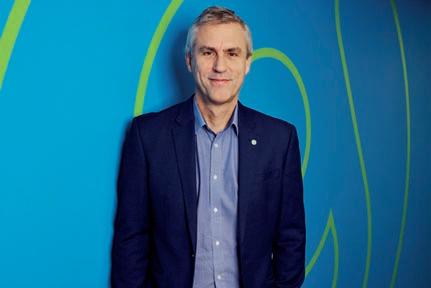
the assessment of climate-related risks and opportunities. These include the requirements of the Task Force on Climate-Related Financial Disclosures. Further, the Sustainability Committee receives reports from three key workstreams: equality, diversity &
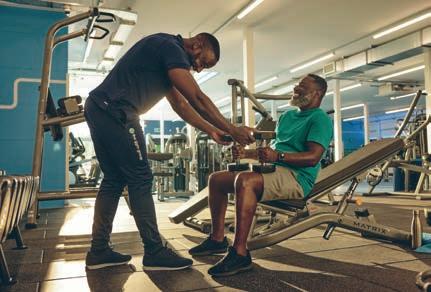
The Gym Group has introduced an ethnic diversity senior leadership team pledge of 20% representation by 2030 from the current 12.5% who identify as black, Asian, mixed or other ethnic background
inclusion (EDI); environmental, social & governance (ESG) and health, safety & wellbeing. According to the company’s recently released Sustainability Report 2023, the board “shares The Gym Group’s passion for a sustainable business and the delivery of affordable fitness for all. The participation of executive members in the sustainability
Sport England is urging organisations in the S&PA industry to invest in environmental sustainability through a series of actions outlined in the recently unveiled ‘Every Move – Sustainability Strategy and Action Plan 2024-2027’.
The strategy and action plan also outlines steps Sport England itself will take to embrace approaches like others, raising the environmental responsibility profile with organisations.
For instance, environmental sustainability reporting will be integrated into Sport England’s regular financial and public reporting by March 2025. Also, the organisation will deliver a supplier engagement programme, with key suppliers required to provide evidence of 2026-27 sustainability by March 2027. And in another requirement, all Sport England staff must be aware of and abide by relevant policies related to business travel by March 2026.
Those are just three items included within more than a dozen pages of actions set out for coming years. Not only does the strategy take on administrative
activity supporting sustainability, targets to benefit the natural and built environment are incorporated, “addressing each location’s unique challenges and opportunities to create and maintain high-quality environments that encourage people to move more, reduce emissions and enhance biodiversity”, the plan says.
One example is around new 3G artificial grass pitches, the sand/rubber infilled sports synthetic surfaces used in football and rugby: Sport England will work with partners and stakeholders, including the Football Foundation, to explore viable alternatives to the rubber infill used in third generation 3G artificial grass pitches and improved recycling opportunities and processes, given concerns about plastic pollution and waste.
Underscoring all the elements of the strategy is the call for development of a climate adaptation and resilience vision for the sector supported by a Sport England strategy – with the sector vision agreed and the climate adaptation plan developed by March 2027.
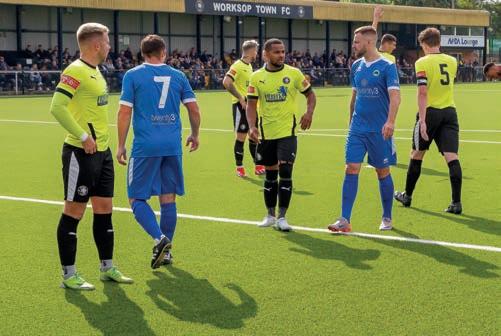

Above: installing up-to-date and sustainable air conditioning units is essential in modern gyms
committee demonstrates our commitment to integrating sustainability into the heart of our business decisions”.
The report outlines the group’s key sustainability achievements for 2023. They include earning ISO 45001 certification – the first UK national gym chain to do so – which aims to provide a safe and healthy workplace for employees, and is crucial to control all factors that might result in illness, injury and, in extreme cases, death. It differs from previous ISO Occupational Health and Safety standards in that it concentrates on the interaction between an organisation and its business environment, the ISO explains.
Another highlight was successfully having had its net-zero greenhouse gases emissions target approved by the Science Based Target initiative (SBTi), a corporate climate action organisation that enables companies and financial institutions worldwide “to play their part in combating the climate crisis”, the SBTi says. It develops standards, tools and guidance, which allow companies to
By Sarah Humphrys
When so many large organisations provide sustainability training, but only 12% of UK workers feel adequately equipped, it raises the question: what’s going wrong? Why does ESG training leave learners disengaged instead of motivated to be agents of change?
The truth is that passive, click-through training modules are boring and forgettable – for issues as crucial as the climate and nature crisis, this approach is simply inadequate.
AimHi Earth suggests a behavioural science-based approach with four ingredients for effective training (see below):
1 Storytelling
Facts alone rarely change behaviour. Messages presented as stories are x22 more memorable, according to change agency Futerra, and will enable trainees to grasp the full picture of the climate and nature emergency, while motivating them to drive change.
2 Interactive elements
This is essential for larger groups: group discussions, debates and responses shift individuals from apathy to agency. These elements retain attention, promote reflection and foster confidence that learners are not alone in their efforts to make a difference.
set greenhouse gas (GHG) emissions reductions targets in line to keep global heating reach net-zero by 2050 at latest. The SBTi is incorporated as a charity, with a subsidiary which hosts its target validation services. The Gym Group worked with the Simple Sustainable consultancy to develop its net-zero targets, and with their approval by the SBTi, The Gym Group became the first gym or health and fitness club in the world to have an approved target. In addition to the overall net-zero target of 2045, The Gym Group committed to increase active annual sourcing of renewable electricity from 23.25% in its 2019 base year to 100% by 2030. And
3
Skills-focused
With one in four Britons believing the climate and nature crisis is already out of control, training must do more than teach people to retain and regurgitate information. It should empower learners to ask good questions and make sustainable decisions. This is key in upskilling employees to be confident changemakers.
4
Engaging production
Training must be concise and dynamic to capture attention amid information overload. Combining science with show-biz and behavioural psychology ensures training is engaging and memorable. This moves diverse groups towards informed action on climate and nature issues.
Whether people learn and act today will shape the world we live in tomorrow. Employers owe their employees the essential skills they need to contribute towards transforming society to one of sustainability and regeneration. The only way to do this is with sustainability training that actually works.
Sarah Humphrys is co-founder of sustainability training company AimHi Earth
among its other targets, The Gym Group has committed to ensuring that 25% of its suppliers – covering purchased goods, services and capital goods – will have science-based targets by 2028.
The Gym Group committed to increase active annual sourcing of renewable electricity from 23.25% in its 2019 base year to 100% by 2030

With regards to EDI commitments, The Gym Group has introduced an ethnic diversity senior leadership team pledge of 20% representation by 2030 from the current 12.5% who identify as black, Asian, mixed or other ethnic background. To support gender diversity, the company launched a Female Health First pilot programme in partnership with The Well HQ to provide employees with specialist knowledge in women’s health and focusing on the specific training and wellbeing needs of female members.

The eight-week programme upskilled 51 employees across 18 gyms and gym support functions. The report says female-specific classes within those gyms have been launched. This year, about 70 more employees will be added to the programme across 60 gyms.
The Gym Group’s business model itself – ‘low-cost, high-quality’ gym services without expensive add-ons –actually helps the organisation keep a healthy level of control on its environmental commitments. “From its original conception, that was "
absolutely about stripping out the, what you might call, ‘unnecessary frills’,” agrees Melhuish. “So we don’t have cafes, or saunas and steam rooms, and we don’t have any swimming pools. It was all about providing gym facilities at the lowest possible costs to make affordable access for people who previously couldn’t afford to go to the gym because it came with a price tag.”
And what does the future hold for The Gym Group, in addition to aiming high for its net-zero targets? The
company is in the process of trialling and testing solar panels on the roofs of its gyms. Currently, Melhuish says, the company’s sustainability ambitions and achievements do not necessarily translate into more gym members. “It’s a ‘nice to have’ but not necessarily a driver of people committing to spend,” he says. “We will always try and keep it above the line and talk about it.”
For more about The Gym Group’s sustainability strategy, visit www. thegymgroup.com/gym-sustainability












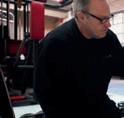



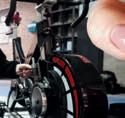








Practitioners in the sport and physical activity industry needn’t be fearful of artificial intelligence taking over their roles

MBy Patrick Appleton
etathesiophobia is the condition which makes people afraid of change. It is a common phenomenon, as last year a research study of 2,000 British adults found that 41% are “creatures of habit” and half wished they were more spontaneous. That reinforced a 2019 study by cloud accounting provider Free Agent that found 71% of respondents said “any variation” in their lives was hard. The 2019 study also found that 68%













(seven in 10 people) believe a fear of change is “irrational”. Similar to that, a small number of 13% didn’t update software on their devices for fear of the change it would bring. Noticeably, 15% kept to the old way of completing tasks in their workplace, even when more efficient systems were introduced.
Most of these are small numbers, and the general feeling is that a fear of change is irrational, but it is those few that need help and coaxing round to the new way of working with AI to deliver a better experience to all in the physical activity sector.
Ian Mullane is at the vanguard and says that while people might be right to be wary of AI, it should be looked at as a brave new dawn rather than a dystopian future to worry the rank and file of the industry.
Mullane is CEO of Keepme, a key player in the AI domain in the sector. The sales and marketing platform has just 43 staff in five different countries worldwide alongside its UK operation, and “north of 500 clubs” from Viva Leisure in the Australian capital Canberra to Inverclyde Leisure in the west central Lowlands of Scotland.
“I think the artificial intelligence for our sector will be something which will help us to start delivering on some of the member experiences that we’ve hoped to do so for a long time now,” says Mullane.
He believes this to be the case due to the following: “A lot of fear is obviously about what impact AI will have on jobs. In my opinion, AI will help this industry add jobs, not subtract.
“Our penetration in the UK as a sector is pretty much 15%, but it fluctuates slightly. You need a catalyst to increase that, and Covid was, for a time, that catalyst as everyone was focused on being fit and [penetration] went up but then went back down to 15% and it hasn’t changed. tha went hasn’t changged
“AI should be looked at as a brave new dawn rather than a dystopian future to worry the industry”
“AI will be that catalyst,” Mullane continues. “And the reason AI will be that catalyst is because many of the challenges that exist in the operator-led experience to a customer at the moment, are solved by AI. I think if you took it to the highest level, the first thing is, accessibility will quite dramatically change because we will have the capability to be able to provide [for the health of the nation].”
Having a daughter with cerebral palsy, the Keepme leader understands the complexities of this all too well. His daughter receives a customised programme, which takes into account her medical diagnosis and receives her programme.
“The level of capability this now has, is that she can isolate muscle groups, pain thresholds and constantly have this evolving training programme,” says Mullane. “So, I think accessibility will be there. It means we’re going to have the capability to look at all relevant disabilities and physical challenges that people may have and then be able to apply them to a certain degree.”
Hassan Ugail, professor of visual computing at the University of Bradford, highlighted the importance of this new AI revolution, and said it is adding a layer of automation on top, rather than replacing roles wholescale, as feared (see box overleaf).
“We have been doing this for the past 5,000 years,” says Ugail. “Let’s imagine when farming came; we developed machinery to help us
plough better, and that alleviated people’s hard work and toil on the farms. I don’t think it replaced anybody then either. It just helped us to do our jobs more efficiently.”
Ugail says that, generally, humans don’t like things that take time to achieve the end goal. They want it fast. He says humans have “been obsessed with this [simplifying] automation”.
“Technological advances have been happening more over the last 20 or 30 years, and AI is not a very new concept – it is at least 60 years old,” he muses. “People have been talking in recent times about creating a machine algorithm that can think for itself like a human brain. This is an issue, when people say, ‘Oh, I don’t want to create a machine to think like me’. [Computing and AI tech] are not able to do that. It’s not possible with datasets.”
Looking back through the past, of course jobs will change, and industries change, too. On the whole, it’s usually for the better, and as Ugail says, the human race cannot replicate a brain to its fullest extent, even though some AI technologies have a dystopian feel.
There is a huge belief in the AI industry and those working in AI in the fitness sector that they are not the bad guys, and having it broken down and disseminated across the S&PA industry will naturally help calm any fears that ‘the robots are coming’. Change will happen, but the industry needs to learn to allow that to happen and embrace it, as one champion of AI puts it.
Ollie Bell is co-founder and CEO of Roster, a web3 company (and CIMSPA Training Partner) helping individuals understand the emerging technology and apply it through web-ready learning courses in blockchain, mini-MBAs (Master of Business Administration), cryptocurrency and decentralised autonomous organisations.
“If we look back at history, any kind
HASSAN UGAIL IS PROFESSOR OF visual computing at the University of Bradford. As reported by the BBC, Guardian and other outlets, he has previously used predictive AI to discover that Raphael’s Madonna della Rosa (Madonna of the Rose), which has intrigued art connoisseurs and experts for centuries, was not completed in full by the master, with another different individual completing Joseph in the painting. That AI algorithm looked intricately at 49 uncontested works of the master and can recognise a true Raphael with 98% accuracy. Here, Ugail explains the nature of the two different artificial intelligences that are becoming ever more present in our day-to-day lives.
PREDICTIVE AI
“Predictive AI teaching an algorithm to actually predict something, let’s just say a very simple case. You gather a bunch of images of apples and then show the images to the algorithm so it can learn what an apple is. Then if you show an apple to it, the predictive AI says ‘Yes, this is an apple’ and if you show it a pear it will know ‘This is not an apple’. It’s a binary classifier, in that ‘it is’ or ‘it isn’t’. We have been doing this kind of work and have an interesting project currently with NHS and the National Institute of Health Research, teaching the AI machine what a good organ looks like and what a not-so-good
of major revolution in technology disrupts – and displaces jobs,” says Bell. “It will make more efficient, the tasks that different jobs have to do, but it won’t make them redundant. It will just displace skills that are required to be a valuable member of the workforce currently.
“It will enhance [one’s] ability to do things more quickly, or better, or more
organ looks like. The surgeon score of the image is correlated with the AI machine and it can learn what a good or bad liver will show up as by looking at it.
“In the last couple of years, the generative AI has sprung up and in that AI what we’re doing is a very different thing. What we’re doing is putting datasets into the algorithm, so giving datasets all the text available and accessible on the internet. Then you feed that AI machine and ask it to conjure up something new, based on what is learnt and has gone before. As far as ChatGPT, that doesn’t know what it’s doing, just that it has been told to search a dictionary, taking a pool of billions of words in there, and then just picking one by one, obviously with a given sort of statistical criteria. That’s why it makes sense.
“In fact, it is as dumb as anything else. Having said that, it’s actually very good in automating, that kind of thing. I use GPT every day to write my code, so I ask it, ‘Give me a piece of code to do this’. It will simply just go away and give me line-by-line code for me. This is great for me, as with this piece of code I could make many errors, but it doesn’t make any mistakes. It knows this but doesn’t strictly mean it’s intelligent. All it does is figure out a pattern of making something more efficient.”
accurate. We will have more time to do other things,” he says.
Another issue that the Roster CEO describes – which Keepme’s Mullane also cited – is the idea of self-scan checkouts for gyms or the fitness sector in a large setting.
“AI can be used at the front end of a sales journey where someone has to speak to a prospective buyer or a client
for a personal trainer or a member for a leisure centre,” continues Bell, a former commercial director of CIMSPA.
“AI can collect all that data and shortcut to a phone call or web journey that then presents the best offer for that person. In practice, I think it would work like a self-scan machine. There’s no reason every leisure centre in the country couldn’t have at least one that performs better than reception.”
Going one step further, Bell adds that these future tools could “scan me as a member, let me login and know everything about my visits past and present and what I want and need”.
“There are also interactional opportunities to gain my custom –‘Ollie, did you like that Pilates?’ ‘Did you know yoga runs on a Tuesday?’
One individual on reception can’t do that job, whereas technology can,” he says. “Those kinds of things are where AI can really come in and make a big difference.”
Mullane says that for AI and the sport and physical activity sector to work in harmony, personalisation is key.
“The higher a level of personalisation







“[AI] will enhance [one’s] ability to do things more quickly, or better, or more accurate”
we can give, the highest probability that member will get their outcome and also stay with us,” he opines.
“However, it is only now through the capabilities of AI and automation, where we’ve got that level of insight that allows us to personalise; AI provides us the personalisation, and automation gives us the ability to deliver the personalisation at scale.”
The Keepme CEO stands firm against the question of job losses and hammers home his own opinion that other industries should be quaking in their boots at AI much more than the physical activity sphere.
“I don’t think [job losses] will be at all in fitness. I think fitness will increase, not decrease.









“Just like when we had the Industrial Revolution before, roles will be refined and there will be entirely new roles that people have never even contemplated being a part of. There was no such thing as a podcaster 20 years ago – there’s always an evolution.”
Bell agrees with Mullane and Ugail that people need to adapt and be ahead of the curve when it comes to using AI at work. He believes that “like every other major generational shift in technology, AI will become adopted and become commonplace”.
The hype around AI is very real, and with Silicon Valley firms throwing money at it, considerable advancements are likely even a year from now. The AI market is projected to reach $184bn (£144.7bn) in 2024, according to statistics provider Statista. It is expected to show an annual growth rate of 28.46% and has been predicted to reach $826.7bn (£650.4bn) by the end of the decade.
All businesses will be using AI in the same way all used social media. Bell says that the world will go through a “kind of behaviour shift”, and one such comparison from the past is that “social media [was] for college kids to have profiles at Harvard”. Today, he says, it’s for the public, to ‘find people’, ‘dating’, ‘meeting friends’ and ‘sharing content’.
“To be a content platform now, it’s completely impossible to have a marketing strategy without considering social media,” he concludes.
“Employers would look at any individual member of the workforceas a marketing professional - who didn’t have experience in [social media] as not good enough for a job if they’re failing to move on. AI will be exactly the same.”




In the next issue of S&PA Professional, we will explore how those who work in the sector can get practical insight into AI.
From working your glutes to using military-level sports watches, we have you covered
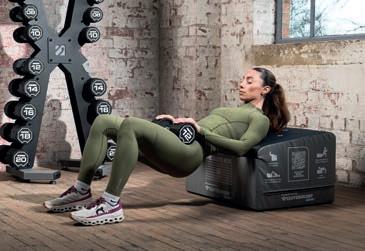
Escape Fitness is launching a dedicated glute equipment range in partnership with glute training specialist Glutebuilder. Kicking off the range is the Escape Glute Box, which claims to offer an affordable and portable glute training option that can be used in a functional training space, free weight training area or even a hotel guestroom. The hybrid box with patented angled design creates a surface for the performance of up to 30 glute exercises. It is manufactured from a durable, synthetic material stretched over a dense foam interior, overlaid with a vinyl anti-slip top and bottom. It works as both a standalone training aid or as a partner to a barbell or training bag. The Glute Box is supported by a library of digital exercise demonstrations and workouts, which can be accessed via Escape’s Mars 2.0 touchscreen. Escape Fitness reports that Glute Rack will follow later this year. www.escapefi tness.com


Polar has unveiled its nextgeneration, ultra-durable outdoor sports watch, the Polar Grit X2. Reportedly built to the latest military 810H standards, it claims to withstand the most demanding conditions, including high altitude, low pressure, exposure to high and low temperatures and immersion corrosion. It features an AMOLED touchscreen display with scratch-resistant glass and biosensing technologies powered by Polar Elixir. It also provides navigation and routing tools with dualfrequency GP and includes built-in topographic maps, turn-by-turn navigation and Strava route sync. The Grit X2 features 140-hour battery life in eco training mode and is capable of 43 hours’ battery life in performance training mode.
Price: €749.90 (£642) for Night-Black or Stone-Gray colours https://www.polar.com/uk-en
A group of key industry bodies, including CIMSPA, are launching a chemical incident register to help the sector improve standards of chemical handling and tackle the rise in accidents and incidents. The rise in incidents (the threeyear average between 2021-2023 is up by 62%, according to figures from the Water Incident Research Hub) led to the formation of the Pool Chemical Forum, hosted by the CBA (Chemical Business Association), and including the Institute of Swimming (IOS), Swimming Pool and Allied Trades Association (SPATA), Pool Water Treatment Advisory Group (PWTAG), Royal Life Saving Society UK, Brenntag UK, ukactive and CIMSPA. The Forum aims to collect meaningful data about incidents, which will be independently and anonymously shared with the pool industry approximately every quarter. https://uk.surveymonkey.com/r/GZDWFS8

Myzone gym users can now experience the benefits of the company’s heart rate training biome through their existing Apple or Android smart watch. MZ-open aims to offer a more inclusive route into Myzone’s ecosystem and global community to benefit both users and operators. It reports that its research shows that gym users who engage with Myzone remain

Technogym’s Mywellness Lifestyle customer relationship management (CRM) system is integrating AI to boost revenues and improve workflow efficiency. The Technogym ecosystem – at the operator and consumer end – is being unified by the Technogym AI Coach. The AI behind the CRM will automate the whole customer journey while providing operators with an interactive interface, which includes detailed metrics and analytics on each user. It collects and tracks data from all touchpoints of the connected system, including Technogym App, Technogym Checkup, Technogym Visio, Mywellness Kiosk and smart consoles. To customise and automate journeys, users are clustered depending on their mapped needs, preferences and habits. Technogym AI Coach follows the launch of the Technogym Checkup AI-based assessment station, which calculates wellness age and aims to prescribe an individual’s training protocol that adapts over time. https://www.technogym.com/en-GB/
members 24% longer than those that don’t. Previously, Myzone was only available on its own brandwearable devices. Users pair their Apple or Android smart watch with Myzone and once activated can access the Myzone ecosystem providing heart rate training, fitness tests and real-time feedback. They can scan a QR code and also join live gym boards as well as earn Myzone Effort Points (MEPs). www.myzone.org/mz-open

As professionals working in health and fitness you’ll know that the inspirational talks given by successful sports personalities are grounded in experience and hard work. But how can the lessons from sports performance be transferred to business organisations?
We’ve done our own hard work, spending time researching for our new book, Rest. Practise. Perform. From this we’ve found three essential lessons that all organisations can learn about performance from elite sport.
Our research explored three very different elite sports: F1, tennis and football. In each, people are able to define what sustainable performance means for them; something that is often not clearly defined in business organisations.
In our research we did find some performance parallels with organisations. For example, sometimes people perform all together, as in football. This could be a key event or sales pitch. Sometimes the work requires making sure that a key person has everything they need to perform. And at other times, everyone is performing at different times, building up to some kind of finale. This is common in a product development process, for example.
The techniques behind Rest. Practise. Perform. can teach valuable tips on sustainable performance and wellbeing too. That’s because we found that strategies within elite sports use a combination of well-designed rest and a lot of the right kind of practise, all of which lead up to an intense performance window to produce sustainable and successful results.
We discuss them in more depth here,


What can F1, tennis and football teach the world of business?
By John McLachlan
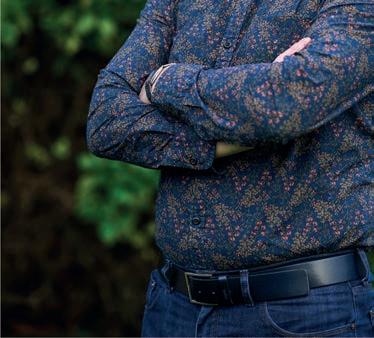


along with suggestions as to how they can be built into a team or business, ideas you may wish to discuss with your clients.
There is a common belief in many organisations that you have to perform 24/7 in order to be successful. Far from resulting in increased innovation and productivity, this is a recipe for burnout and mediocre results. In sport, the ‘performance window’, the period of time you are required to be at maximum performance, is clear. It is the race or match itself.
Organisations should not be aiming to perform constantly but instead should define their equivalent of the race or match. Key questions include ‘When do you really need to be at your best?’, ‘When will it have maximum impact on the outcome?’. For some people it will be a key event or meeting, for some it will be just before some kind of tangible deliverable. A performance window is intense and energy draining, so energy should be expended when it counts, and not wasted on long hours and heroic efforts.
Many people outside sports think that resting is tantamount to doing nothing. Elite sports have a different, and useful, perspective on rest. Instead of stopping completely and quickly losing fitness, they focus on resting that which has been lost through the performance window. That’s why so many build in different types of activities that give them a break from intense competition. What they really need
“We found that strategies within elite sports use a combination of welldesigned rest and a lot of the right kind of practice, all of which lead up to an intense performance window to produce sustainable and successful results”
is a break from the pressure of competition, rather than pure exhaustion. Many find this in sports that they don’t compete in but do just for fun.
Organisations can learn a lot from this and build it into their rhythm. Just like sports people, employees need to rest what it is they use up in the performance window. This may be less physical, but no less important. For example, HR professionals may need a break from intense emotional situations or creative designers may get rest from doing something practical rather than creative. This can be organised through some kind of rotation of responsibilities, or by planning certain kinds of ‘rest’ activities during quieter periods.
You may have experienced the fact that many organisations do not invest time and resources to helping teams to practise the skills and capabilities need for performance. Not only do sports professionals train for much longer timewise than they actually compete, as you know they use strength training, nutrition and mental coaches. A lot of practice goes into making sure they are 100% ready for their performance window. It’s why sports professionals now remain at the top of their game later in life and more are managing to stay free of injury for longer.
In organisations, the key skills and capabilities are not always obvious. Like nutrition and mental coaching in sports, some of the seemingly peripheral, though essential skills are frequently discounted or overlooked. This includes leadership and management skills, the ability to negotiate and manage conflict and time management. Organisations don’t need all of these skills all of the time, the key is to identify the specific traits or skills that will enhance the performance window when in it.
For business leaders who are serious about building sustainable working practices into their organisation, without losing performance, elite sports provide an excellent model. They might need more of the right kind of rest or a bit of focused practice in some key areas, and definitely need to define what performance means for their organisation.
John McLachlan is co-author of Rest. Practise. Perform. What elite sport can teach leaders about sustainable wellbeing and performance.
Zumba is an activity that keeps on giving for Russ Welch, an instructor who is just starting to hear again via a cochlear implant
I’ll admit I’m probably not your usual Zumba instructor as I’ve always struggled to hear music, having 90% hearing loss. But I’ve used a big, powerful speaker that allows me to feel the vibrations in the floor. That said, I’ve recently had a cochlear implant fitted, which makes a huge difference. But it means I’m learning to process new sounds from scratch as my brain adjusts. People sound like chipmunks when they talk, but music’s becoming gradually clearer, and I can hear birds singing outside and my cat meowing for the first time, which is wonderful. I still have a lot of work to do to improve even more.
I was also diagnosed with ankylosing spondylitis in 2007. It’s a long-term condition in which the spine and other areas of the body become inflamed, and it reduces flexibility. I’d been given some exercises to do, but it was particularly bad around the time I found out about Zumba. To be honest, I had no idea what it was, but wow has it helped! I think my rheumatologist was really surprised with how it improved my flexibility.
I originally started going to Zumba Gold classes, which uses the original moves but at a lower intensity. I did that for about six months and then moved into Zumba Fitness classes, which are higher impact. I had a brilliant

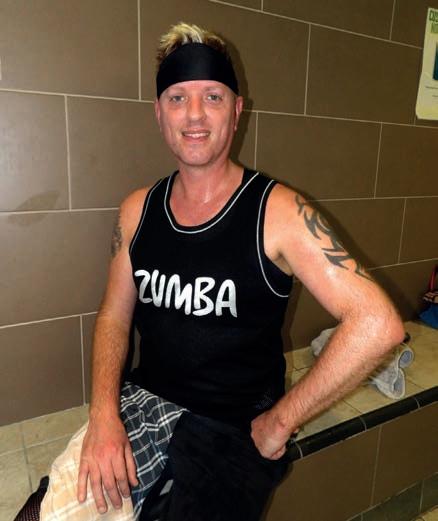








instructor who told me I should become an instructor, so I did. I got my instruction certificate in 2016. It’s taken a while for my classes to grow and develop, but when I look back at my original videos from that time, I see such enormous improvements.
I’m now teaching about eight classes a week in various halls and leisure centres throughout Norfolk and Cambridgeshire. The only thing that stops me doing more is that I’ve got arthritis in my feet, which has recently got worse and creates a lot of swelling. I’m determined it’s not going to stop me. I always say even if I lost a leg, I’d still keep doing Zumba somehow.
I guess I’ve always loved dancing. I was at school when bands like Steps came along, and I started learning their routines and choreography. I’d teach them to my friends and we’d perform them on stage. I’m far from a
professional dancer, but I love making it fun for everyone. I’ll often do silly moves to make everyone laugh or I deliberately go in the wrong direction. I love seeing everyone smiling at the end of the class. I believe it can genuinely help people through depression, mental health or stress at work. I try to take their minds off their worries. And it makes me happy too.
“I’m pleased to be getting more men attending. I think a lot of them think Zumba is too feminine, but the ones that do turn up really seem to enjoy it”
My classes are technically for 16-plus people, but anyone can come along. It’s mainly women, but I’m pleased to be getting more men attending. I think a lot of them think Zumba is too feminine, but the ones that do turn up really seem to enjoy it. Everyone is welcome. I always talk to people one-to-one to learn about any health issues they may have or just to put their minds at ease.
I personally owe a lot to Zumba. I had a very hard childhood. My dad was very violent towards me, something that only got worse when I finally opened up about being gay. Thankfully, I found a partner and we got married. And discovering Zumba and becoming an instructor made me feel like I could really change my life for the better.
In fact, without it I think I’d be in a wheelchair by now because of the ankylosing spondylitis. The condition is supposed to be getting progressively worse, but in fact my rheumatologist is stunned that I seem to be getting more flexible instead. They’re really impressed and have told me to keep on going with it.
I think Zumba helps me get through life generally and I like to think it has the same effect for those who come to my classes. In fact, they tell me I give them a Happy Hour that keeps them going for the rest of the week.
Yes, the income could be better, but I just love it as a job and the fact that it’s making a difference to people’s lives. I also work two days a week for Bedazzle Arts, a performing arts education charity for young people in Cambridgeshire and Essex, and use my Zumba routines there too.
I’m 42 years old now. It’s taken a few years to get there, but Zumba has changed my life and made me feel so much more confident.
Russ Welch spoke with journalist Dean Gurden.






























